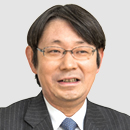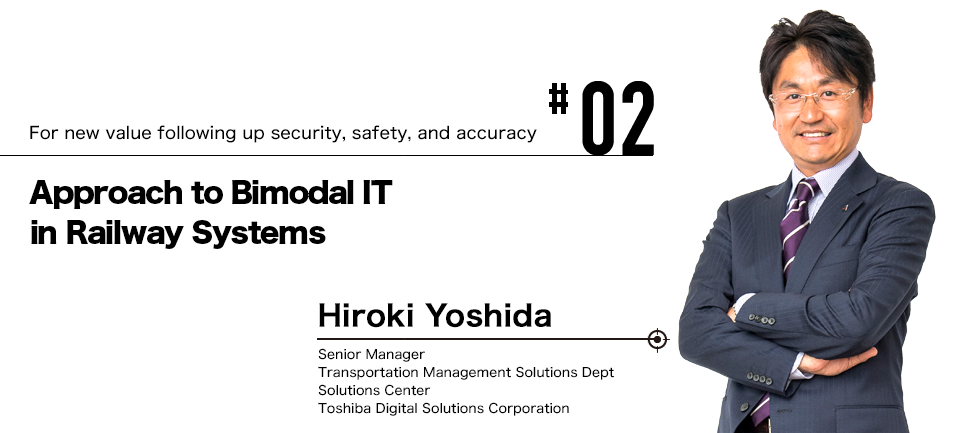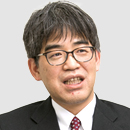Railway systems require high quality signal and train monitoring and control in order to transport customers safely. At the same time, the systems are made up of complex systems that quickly process massive amounts of data and provide it to employees in the field. These systems have common needs for security, safety, and accuracy, and a great deal of emphasis has been placed on system stability and reliability. However, as social environment of Japan changes because of its population shrinking and aging, railway companies have begun measures aimed at creating new business models that do not rely on expanding transportation volume or developing areas along railway lines. Toshiba Digital Solutions has a long history of supporting IT systems of railway companies, and is responding to these changes in society and customers. Our goal is bimodal IT, focusing on both conventional Systems of Record (SoR), which emphasize stability and reliability and seek to improve operation efficiency, and Systems of Engagement (SoE), which emphasize flexibility and agility and seek to create new value.
Railway systems keep their distance from the outside
Under the railway systems of Japan, known as the "legs of the Japanese people," trains arrive exactly
on time and carry passengers just as scheduled. Toshiba has a long history of supporting the railway
systems, consistently praised for its safety and accuracy.
We primarily provide three types of systems. "Train traffic control systems" monitor the operation
conditions of trains every day, automatically controlling signals and train courses based on the
schedule. “Transportation planning systems” are the foundation of train operations. The system
create schedules, determine train operation plans and carriage compositions, create inspection
plans, and formulate crew operation plans, and communicate these information to railway stations,
yards, and other sites. Lastly, “Supervisory Control And Data Acquisition (SCADA) for power supply
systems” monitor and control the electric power transmission and distribution equipment that
provides power to trains (Fig.1).
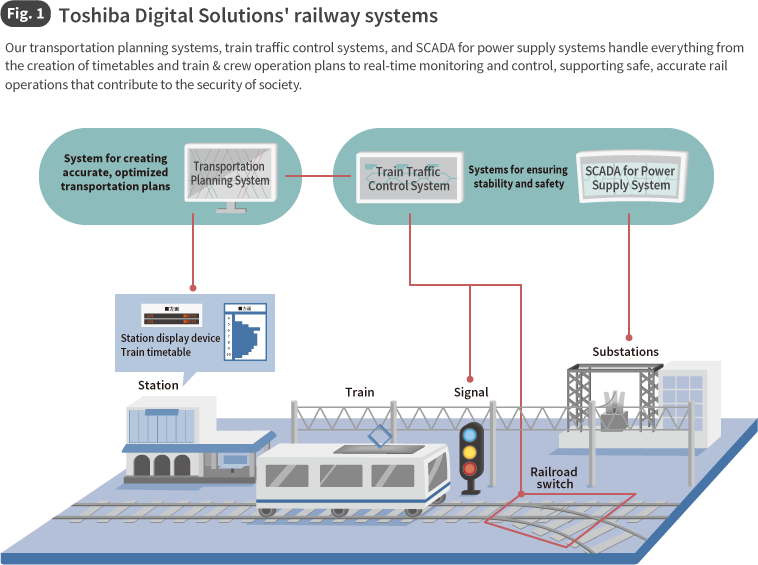
The missions of these systems are supporting the railway transportation, a critical part of social infrastructure, thus a great deal of importance is placed on building systems carefully and operating them precisely. These high-quality systems, so-called SoR, designed with an emphasis on stability and reliability, were developed using the waterfall development approach, based on careful planning and steady implementation of plans.
Transportation planning systems are operated using dedicated servers in facilities owned by railway companies. Even minor problems in train traffic control systems or SCADA for power supply systems can result in train operation suspension, so dozens of engineers take part in their development. All possible operation patterns, including mutual railway use with other railway companies, are identified, the systems are designed, test is performed, and development is carried out with quality as the highest priority.
Public cloud services, which are rapidly growing in popularity around the world, have yet to be actively deployed in railway systems. Railway companies must themselves ensure the security, safety, and accuracy of their systems.
For example, "planning" work consists of deciding on train schedules, carriage compositions, and crew operations, while "current day" work consists of organizing train operations based on the current status of railway operations and performing real-time management of train assignments and crews. "Current day" work requires the timely linking of data between offices, such as head offices and regional offices, with train stations and yards. Cloud computing therefore has potential to meet this requirement. However, it also involves highly sensitive data, such as train schedules, information about electricity, IC pass card data, and the like, so placing data in the cloud, which is directly connected to Internet, has been deemed unfeasible. This tradeoff is the result of the tremendous impact railway systems have on society.
Railway systems require not change, but reliability and stability. System integrators and their engineers have needed project management abilities with strong leadership and high quality, using traditional methods based on a foundation of accumulated operational expertise. However, this tendency has begun to change in recent years.
Click here to move to the top of this page.
The limits of mass transport and the need for a new business model
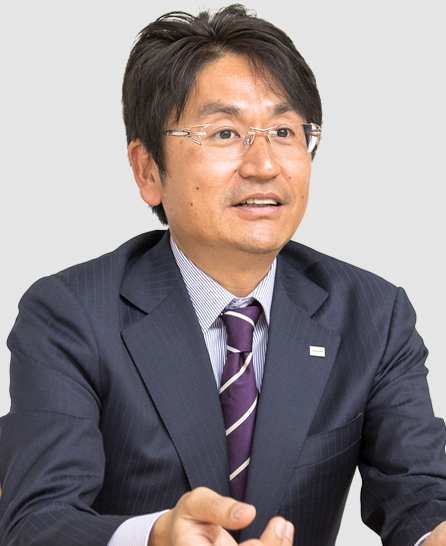
Until now, railway companies have increased sales by growing their customer base as the population increased. Multiple tracks have been installed for railway lines, schedules have been packed to their limits, and carriage interiors have been expanded to increase capacities. Railway companies have focused on making it possible for as many passengers as possible to travel in comfort, and have worked to improve station premise and develop areas along railway lines. However, as population in Japan grows older and smaller, railway companies' main train and facility customer base, regular passengers such as business people, students, and residents living near railway, is shrinking. The conventional business model, which relies entirely on mass transport and development of areas alongside railway lines, is beginning to reach its limits. As with other industries, railway companies now face the need to develop a new business model that takes into account the changes in societal conditions.
In addition to offering passengers and the residents of communities near railway lines "safety, security, and accuracy," they are also creating new services that provide pleasant and convenient experiential value. In this new field, the companies are highly motivated to use advanced digital technologies such as cloud technologies and to actively open data such as timetables, occupancy rates, station congestion rates, and the like, so they are beginning to work on SoE. In their efforts to innovate, they are introducing differing perspectives, not just their own company perspective. To accomplish this, they are carrying out initiatives such as working on open innovation by co-creating with or providing support to venture companies or holding application contests to collect business plans from the general public. These applications include games which use positioning information from trains that people are riding on to tell a story, applications which provide information about train arrival times, departure times, and transfer times at a glance, "stamp rally" games for smartphones, and many other applications which provide passengers with new experiential value such as convenience or fun. There is a growing need for innovative ideas that were seldom produced by conventional SoR railway systems.
They are also actively participating in Mobility as a Service (MaaS) activities, which provide seamless transportation by partnering with car rental companies, taxi companies, bus companies, and increasingly popular rental cycle services, which provide transportation between train stations and final destinations. The future may see optimized, user-focused transportation services, such as services which allow tourists, people on business trips, and people going to hospitals to use a single smartphone application to arrange for and pay for taxis, rental cars, nearby hotels, or the like depending on their needs, easily or even automatically.
Click here to move to the top of this page.
Aiming to create new railway value
So, what can Toshiba do for railway companies, which have begun, in earnest, to develop user-focused services? We believe that we can contribute our expertise in railway business, developed over many years, and our strengths with advanced digital technologies, such as the Internet of Things (IoT), Artificial Intelligence (AI), and cloud computing, refined through use in the manufacturing and numerous industrial fields. We want to leverage these expertise, technical capabilities, and our relationships of trust to work with customers to actively develop and supply services that provide true value.
Together with Railway Systems Division of Toshiba Infrastructure Systems & Solutions Corporation, we are considering various methods for implementing automated control in the railway field. Amidst concerns about future labor shortages, automation is coming to be applied to operations that in the past had to be done by hand. Although issues still remain with "person-to-person" planning and control, such as crew operation systems which assign crew member duties, progress is being made with the use of automation in "person-to-train" operations, such as operation monitoring and operation arrangement functions, data collection and integrated management, and AI-based analysis. Unlike in the maintenance field, in the operation field, in the past, sensed values were used in control operations, but there were no functions for saving those values or control actions as data. We are implementing measures to store and utilize these data to improve control performance and implement automation.
Security & Automation Systems Division of Toshiba Infrastructure Systems & Solutions Corporation is promoting efforts to use advanced digital technologies to further improve railway comfort and convenience. As part of these efforts, they have begun researching systems for moving fare calculation functions, part of station operations, to the cloud. It is also actively participating in co-creation SI engineer training* carried out throughout our Solutions Center, holding "ideathons" to discuss what kinds of functions and services railway users want, and working to create a corporate culture that creates new value.
* Co-creation SI engineer training is introduced in detail in #01.
The railway industry is in the midst of tremendous change. Toshiba Digital Solutions places great value on identifying what is changing and what is remaining the same, developing SoR that provide safety, security, and accuracy, designing SoE that co-create new value from unconventional perspectives, and promoting bimodal IT in which these SoR and SoE coexist and coordinate. We always keep our eyes on the needs of the future, working as one to leverage our state-of-the-art digital technologies and expertise regarding railway business, and implementing systems and services that embody what both customers and the rest of the world want from railway services.
* The corporate names, organization names, job titles and other names and titles appearing in this article are those as of April 2019.
